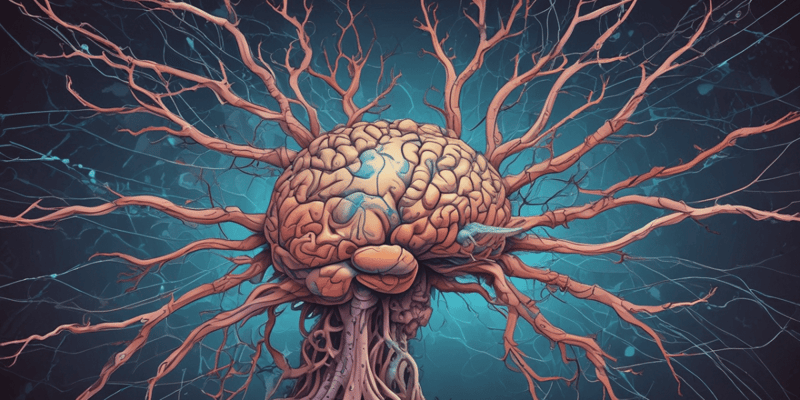42 Questions
What is the primary location of the brain damage associated with athetosis?
Cerebral cortex
What is the term for the sustained postural contractions of the limb, neck, and facial muscles?
Dystonia
What is the primary function of the cerebellum?
Fine control and coordination of simple and complex movements
What is the name of the ovoid-shaped organ that influences the lower motor neurons indirectly?
Cerebellum
What is the region of the brain affected by degeneration in athetosis?
Globus pallidus
Which of the following is NOT a characteristic of athetosis?
Involves rapid, jerky movements
What is the term for the system that includes the cerebellum and influences the lower motor neurons indirectly?
Extrapyramidal System
What is the term for the slow, writhing, worm-like involuntary movement of the extremities, trunk, and neck?
Athetosis
Which type of axons from Purkinje cells of the overlying cortex project to the deep cerebellar nuclei?
Inhibitory
What is the function of the afferent tracts in the cerebellum?
To receive sensory information from the body and transmit it to the cerebellar cortex
Which of the following is an efferent tract that connects the cerebellum to the midbrain?
Superior Cerebellar Peduncle
What is the function of the efferent tracts in the cerebellum?
To transmit motor signals from the cerebellum to the brain and spinal cord
Which nucleus is the only one that exits the Inferior Cerebellar Peduncle?
Fastigial nucleus
Which peduncle connects the cerebellum to the medulla oblongata?
Inferior Cerebellar Peduncle
What is the function of the deep cerebellar nuclei?
To integrate afferent information from different sources
Which of the following is NOT an afferent tract to the cerebellum?
Dentatothalamic tract
What is the primary genetic defect in Huntington's disease?
Defect on chromosome 4 (protein huntingtin)
What is the primary outcome of the degeneration of GABAergic neurons in the caudate nucleus?
Overactivity of dopamine-secreting neurons
What is the name of the pathway that is inhibited in Huntington's disease?
Nigrostriatal pathway
What is the characteristic movement disorder in Huntington's disease?
Chorea
What is the name of the disease that is associated with rheumatic fever and is caused by Streptococcal antigens?
Sydenham's chorea
What is the name of the structure that is affected in Sydenham's chorea?
Striatum
What is the primary function of the basal ganglia?
Modulating the 'final common pathway' indirectly
What is the characteristic feature of the basal ganglia's effect on movement?
Contralateral to the side of the lesion
Which of the following structures sends afferent neurons to the deep cerebellar nuclei through mossy fibers?
Middle cerebellar peduncle
What is the primary function of the corticopontocerebellar pathway?
Control of voluntary movement and initiation of movement
Which cerebellar peduncle carries fibers from the inferior olivary nuclei to the cerebellum?
Inferior cerebellar peduncle
What type of fibers terminate in the cerebellar cortex as a result of the cerebro-olivocerebellar pathway?
Climbing fibers
Which structure receives afferent neurons from the spinal cord?
Cerebellum
What is the direction of the signals in the superior cerebellar peduncle?
Out of the cerebellum
Which pathway is involved in the transmission of signals from the cerebral cortex to the cerebellum?
Corticopontocerebellar pathway
Where do the fibers from the cerebral cortex terminate bilaterally after descending through the corona radiata and internal capsule?
Inferior olivary nuclei
Which cortical areas provide information to the corticopontocerebellar pathway?
Primary motor and sensory areas, and associate areas
What is the termination point of the corticopontocerebellar pathway?
Pontine nuclei
Which pathway crosses the midline and enters the opposite cerebellar hemisphere?
Corticopontocerebellar pathway
What is the origin of the reticulocerebellar fibers?
Reticular formation
Which pathway has fibers that terminate on the same side and the opposite side?
Cerebroreticulocerebellar pathway
What is the function of the anterior and posterior spinocerebellar tracts?
Transmitting information from the spinal cord to the cerebellum
Which pathway is responsible for transmitting information from the somatosensory receptors?
All of the above
Where do the fibers of the corticopontocerebellar pathway descend to before terminating in the pontine nuclei?
Internal capsule
What is the name of the pathway that originates from the spinal cord and terminates in the cerebellum?
Spinal cord to cerebellum pathway
What is the common name for the fibers that originate from the cerebrum and terminate in the cerebellum?
Cerebellar afferent fibers
Test your knowledge of Huntington's disease, a genetic disorder characterized by involuntary movements and progressive dementia. Learn about the causes, symptoms, and effects on the brain.
Make Your Own Quizzes and Flashcards
Convert your notes into interactive study material.
Get started for free


